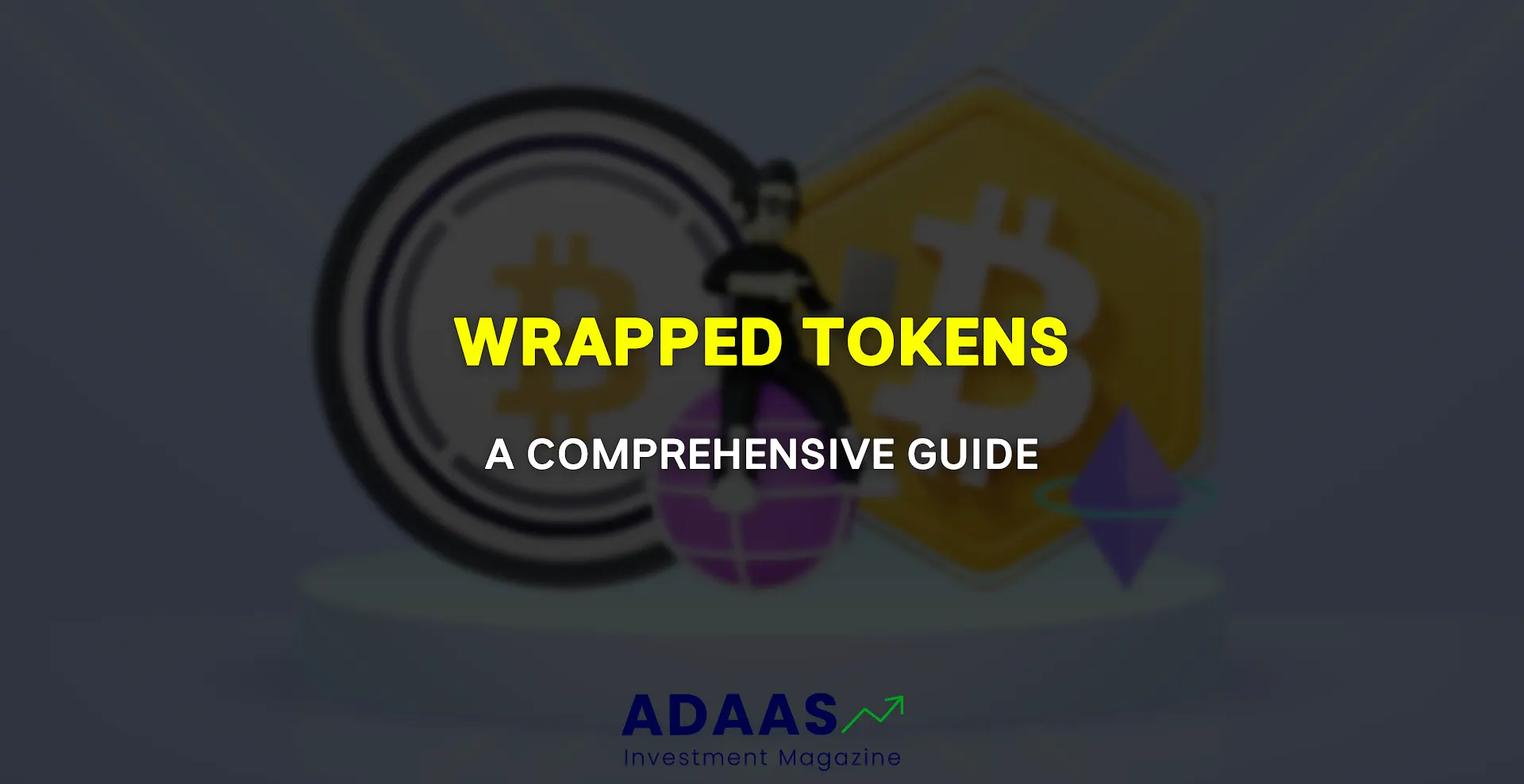What Is Wrapped Token?
Unlocking the Potential of Wrapped Tokens in Blockchain
By reading the article “What is a Wrapped Token” published in Adaas Investment Magazine, you will be fully familiar with what wrapped tokens are, how they work, and their role in the blockchain ecosystem. This level of familiarity can be enough when you need educational information about this topic.
Wrapped tokens are one of the most innovative and exciting developments in the crypto space. They allow users to interact with and use their favorite cryptocurrencies on different blockchain networks, including those that they do not natively support.
But what exactly is a wrapped token? And how does it work?
In this post, we will explore the world of wrapped tokens and explain everything you need to know about them. We will also discuss the benefits of using wrapped tokens and the risks and challenges associated with them.
What is a wrapped token?
A wrapped token is a digital asset that represents another cryptocurrency on a different blockchain network. In other words, it is a tokenized version of another cryptocurrency.
Wrapped tokens are created by a custodian or protocol that locks up the underlying asset in a secure vault and mints an equivalent amount of wrapped tokens. The wrapped tokens are then distributed to users, who can use them on the blockchain network where they were minted.
How does a wrapped token work?
The technical process of wrapping tokens varies depending on the custodian or protocol involved. However, the general process is as follows:
1- The user deposits the underlying asset with the custodian or protocol.
2- The custodian or protocol locks up the underlying asset in a secure vault.
3- The custodian or protocol mints an equivalent amount of wrapped tokens.
4- The wrapped tokens are distributed to the user.
Why are wrapped tokens becoming popular?
Wrapped tokens are becoming increasingly popular in the crypto space for a number of reasons, including:
– Increased liquidity: Wrapped tokens allow users to access liquidity on different blockchain networks. This is particularly beneficial for cryptocurrencies that are not natively supported by popular Decentralized Finance (DeFi) platforms.
– Cross-chain compatibility: Wrapped tokens enable users to interact with and use their favorite cryptocurrencies on different blockchain networks. This is essential for cross-chain applications, such as decentralized exchanges and bridges.
– Improved usability: Wrapped tokens can be used in the same way as native tokens on a blockchain network. This makes it easier for users to interact with and use their favorite cryptocurrencies on different platforms.
Wrapped tokens are a powerful tool that can be used to unlock the full potential of the crypto ecosystem. By understanding what wrapped tokens are and how they work, you can start using them to your advantage.
In the next section, we will take a closer look at the benefits of using wrapped tokens and the risks and challenges associated with them.
Table of Contents
What Is Tokenization?
Tokenization is the process of converting a physical or digital asset into a digital token. This token can then be traded, stored, and used on a blockchain network.
Tokens can represent a wide range of assets, including:
- Cryptocurrencies
- Securities
- Real estate
- Collectibles
- Intellectual property
- Carbon credits
What does a token represent in the digital world?
A token represents a digital asset that has been stored on a blockchain network. It is a unique identifier that is associated with the asset and its ownership.
Tokens can be used to represent ownership of physical assets, such as real estate or gold. They can also be used to represent ownership of digital assets, such as cryptocurrencies or in-game items.
What is the role of tokens in blockchain ecosystems?
Tokens play a vital role in blockchain ecosystems. They are used to:
– Represent ownership: Tokens can be used to represent ownership of assets, both physical and digital.
– Facilitate transactions: Tokens can be used to facilitate transactions on blockchain networks. For example, Bitcoin and Ethereum tokens are used to pay for transaction fees on their respective networks.
– Provide access to products and services: Tokens can be used to provide access to products and services on blockchain networks. For example, utility tokens are used to access products and services on decentralized exchanges and other DeFi platforms.
Benefits of tokenization
Tokenization offers a number of benefits, including:
Liquidity: Tokens can be traded more easily than traditional assets, such as stocks and real estate.
Divisibility: Tokens can be divided into smaller units, making them more accessible to investors.
Transparency: Transactions involving tokens are recorded on a blockchain network, making them transparent and tamper-proof.
Efficiency: Tokens can help to streamline and automate business processes.
Accessibility: Tokenization can make it easier for people to invest in and access new asset classes.
What Are Wrapped Tokens?
Wrapped tokens are a type of digital asset that represents another cryptocurrency on a different blockchain network. In other words, a wrapped token is a tokenized version of another cryptocurrency. This allows users to interact with and use their favorite cryptocurrencies on different blockchain networks, including those that they do not natively support.
How are wrapped tokens created?
Wrapped tokens are created by a custodian or protocol that locks up the underlying asset in a secure vault and mints an equivalent amount of wrapped tokens. The wrapped tokens are then distributed to users, who can use them on the blockchain network where they were minted.
What do wrapped tokens represent?
Wrapped tokens represent the underlying cryptocurrency on a different blockchain network. For example, Wrapped Bitcoin (WBTC) represents Bitcoin on the Ethereum blockchain.
Examples of popular wrapped tokens:
- Wrapped Bitcoin (WBTC)
- Wrapped Ethereum (WETH)
- Wrapped Litecoin (WLTC)
- Wrapped Solana (SOL)
- Avalanche (AVAX)
Need for wrapped tokens:
Wrapped tokens are needed to enable cross-chain interoperability. Cross-chain interoperability is the ability to transfer assets and data between different blockchain networks. Wrapped tokens allow users to use their favorite cryptocurrencies on different blockchain networks, even if those networks do not natively support them.
For example, a user can wrap their Bitcoin to create WBTC and then use WBTC on the Ethereum blockchain to interact with DeFi applications. The user can then unwrap their WBTC to redeem their Bitcoin at any time.
How Wrapped Tokens Work
Technical process of wrapping tokens:
The technical process of wrapping tokens varies depending on the custodian or protocol involved. However, the general process is as follows:
1- The user deposits the underlying asset with the custodian or protocol.
2- The custodian or protocol locks up the underlying asset in a secure vault.
3- The custodian or protocol mints an equivalent amount of wrapped tokens.
4- The wrapped tokens are distributed to the user.
Role of custodians or smart contracts in wrapping tokens:
Custodians or smart contracts play a vital role in the wrapping process. Custodians are responsible for holding the underlying assets in secure vaults. Smart contracts are used to mint and distribute the wrapped tokens.
Backing assets and collateralization:
Wrapped tokens are backed by the underlying asset. This means that there is a custodian or protocol holding an equivalent amount of the underlying asset for every wrapped token in circulation.
The collateralization process is the process of locking up the underlying asset in a secure vault. This is done to ensure that there is always enough of the underlying asset to back the wrapped tokens in circulation.
Transparency and security features of wrapped tokens:
Wrapped tokens are transparent and secure. All transactions involving wrapped tokens are recorded on a blockchain network. This makes it possible to track the movement of wrapped tokens and to verify that they are backed by the underlying asset.
In addition, wrapped tokens often use smart contracts to manage the wrapping and unwrapping process. Smart contracts are self-executing contracts that are stored on a blockchain network. This makes them tamper-proof and transparent.
Use Cases and Benefits of Wrapped Tokens
Wrapped tokens have a wide range of use cases in DeFi (Decentralized Finance), including:
Liquidity provision: Wrapped tokens allow users to provide liquidity to DeFi applications on different blockchain networks. This can help to improve the liquidity of DeFi markets and make them more accessible to users.
Trading and investment: Wrapped tokens can be used to trade and invest in crypto assets on different blockchain networks. This gives users more flexibility and choice when it comes to trading and investing in crypto assets.
Cross-chain interoperability: Wrapped tokens enable cross-chain interoperability, which is the ability to transfer assets and data between different blockchain networks. This allows users to use their favorite crypto assets on different blockchain networks, even if those networks do not natively support them.
Real-world examples of projects utilizing wrapped tokens:
AAVE: AAVE is a DeFi lending and borrowing platform that allows users to lend and borrow crypto assets. AAVE supports a variety of wrapped tokens, including WBTC and WETH.
Uniswap: Uniswap is a decentralized exchange that allows users to trade crypto assets. Uniswap supports a wide range of wrapped tokens, including WBTC, WETH, and WLTC.
Curve Finance: Curve Finance is a decentralized exchange that is optimized for trading stablecoins. Curve Finance supports a variety of wrapped stablecoins, such as USDT and USDC.
Benefits of using wrapped tokens for trading and investment:
Increased liquidity: Wrapped tokens provide users with access to increased liquidity on different blockchain networks. This can make it easier to buy and sell wrapped tokens at a fair price.
More trading opportunities: Wrapped tokens give users more trading opportunities by allowing them to trade crypto assets on different blockchain networks. This can help users to diversify their portfolios and to generate higher returns.
Reduced risk: Wrapped tokens can help to reduce the risk of trading and investing in crypto assets. This is because wrapped tokens are backed by the underlying asset, which provides a measure of security.
Risks and Challenges of Wrapped Tokens
Despite the many benefits of wrapped tokens, there are also some potential risks and challenges associated with their use.
Custodial risk: Wrapped tokens are typically backed by an underlying asset that is held in a secure vault by a custodian or protocol. This means that users are trusting the custodian or protocol to safeguard their assets. If the custodian or protocol is hacked or goes bankrupt, users could lose their assets.
Maintaining the peg: Another challenge is maintaining the peg between wrapped tokens and their underlying assets. This can be difficult to achieve, especially during periods of high market volatility. If the peg breaks, users could lose money.
Choosing a reputable custodian or protocol: It is important to choose a reputable custodian or protocol when using wrapped tokens. Users should research the custodian or protocol carefully and make sure that it has a good track record.
Tips for mitigating risks:
Choose a reputable custodian or protocol: As mentioned above, it is important to choose a reputable custodian or protocol when using wrapped tokens. Users should research the custodian or protocol carefully and make sure that it has a good track record.
Use multiple custodians or protocols: To reduce custodial risk, users can choose to use multiple custodians or protocols. This way, if one custodian or protocol is hacked or goes bankrupt, users will not lose all of their assets.
Be aware of the risks: It is important to be aware of the risks associated with wrapped tokens before using them. Users should carefully consider the risks and benefits before deciding whether or not to use wrapped tokens.
Conclusion
Wrapped tokens are a powerful tool that can be used to unlock the full potential of the crypto ecosystem. They allow users to interact with and use their favorite cryptocurrencies on different blockchain networks, including those that they do not natively support.
Wrapped tokens offer a number of benefits, including:
- Increased liquidity
- Cross-chain compatibility
- Improved usability
However, it is important to be aware of the risks associated with wrapped tokens, such as custodial risk and the challenge of maintaining the peg. Users should carefully consider the risks and benefits before deciding whether or not to use wrapped tokens.
If you are interested in exploring wrapped tokens, be sure to do your research and choose a reputable custodian or protocol. You should also start small and gradually increase your investment as you become more comfortable with wrapped tokens.
To learn more about wrapped tokens, you can visit the websites of popular custodians and protocols, such as Wrapped Bitcoin and Wrapped Ethereum. You can also read articles and blog posts about wrapped tokens, such as this one.
Once you have a good understanding of wrapped tokens, you can start exploring ways to use them. For example, you can use wrapped tokens to provide liquidity to DeFi applications or to trade and invest in crypto assets on different blockchain networks.
Disclaimer: Cryptocurrency investments carry risks. Readers should conduct their own research and consider their risk tolerance before using any exchange.

The End Words
At Adaas Capital, we hope that by reading this article you will be fully immersed in What Is a Wrapped Token! You can help us improve by sharing this post which is published in Adaas Investment Magazine and help optimize it by submitting your comments.
FAQ
What does wrapping a token do?
Wrapping a token is the process of converting a cryptocurrency into a digital token that can be used on a different blockchain network. This is done by locking up the cryptocurrency in a secure vault and minting a corresponding amount of wrapped tokens on the other blockchain network.
Are wrapped tokens safe?
In general, wrapped tokens are considered to be safe, as they are backed by the underlying asset. However, there is always some risk involved when using wrapped tokens, as you are trusting the custodian or protocol to safeguard your assets.
What is the most popular wrapped token?
The most popular wrapped token is Wrapped Bitcoin (WBTC). It is a tokenized version of Bitcoin that can be used on the Ethereum blockchain. WBTC is the most liquid wrapped token and is supported by a wide range of DeFi applications.
Other popular wrapped tokens include:
– Wrapped Ethereum (WETH)
– Wrapped Litecoin (WLTC)
– Wrapped Solana (SOL)
– Avalanche (AVAX)
What is the difference between pegged and wrapped tokens?
The main difference between pegged tokens and wrapped tokens is that pegged tokens are designed to maintain a fixed value relative to another asset, while wrapped tokens are simply tokenized versions of existing cryptocurrencies.







